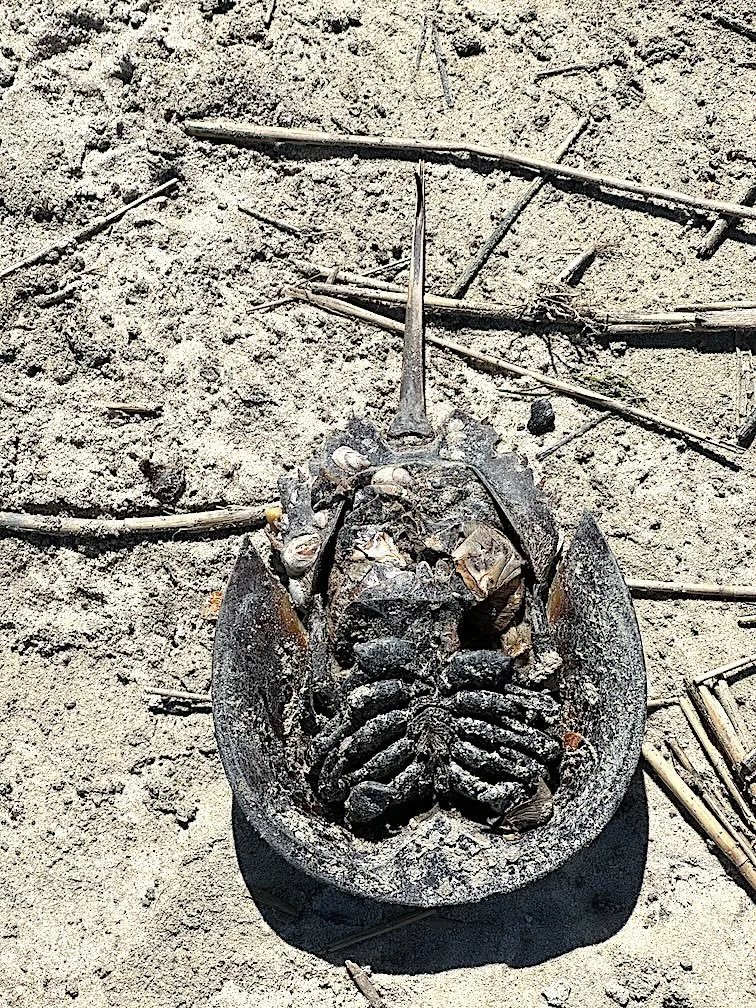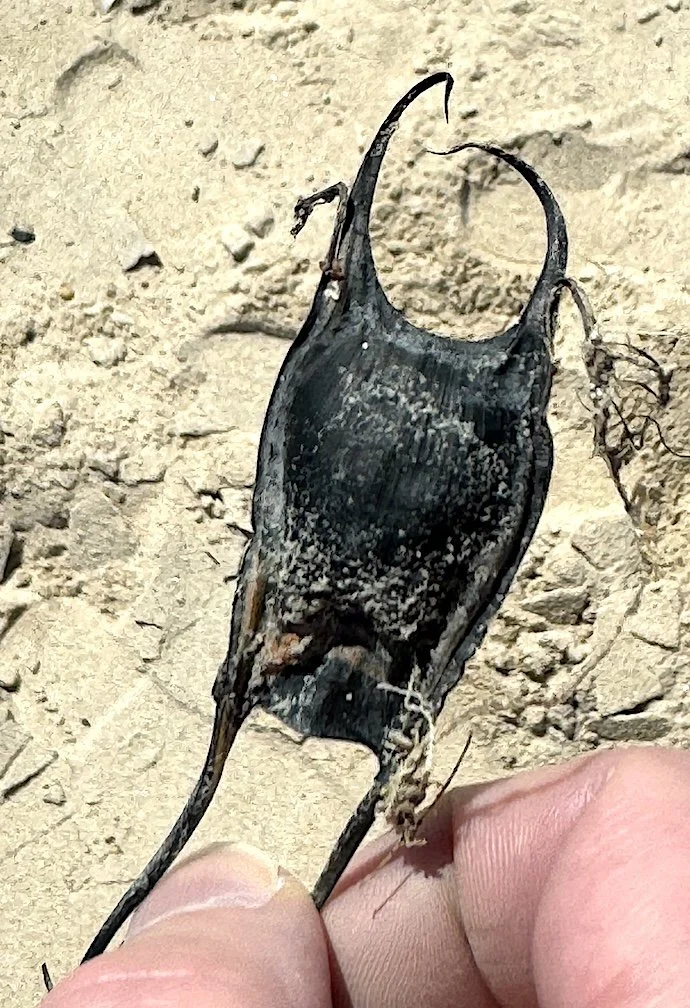A close encounter with the fascinating horseshoe crabs
During a recent visit to Dewey Beach in the state of Delaware (USA), I saw a few unusual creatures in the shallow waters of the bay, one of them (a male) was partially piggybacking on another (female), and other appear to be hanging around. I have never seen a creature like this before, but a friend said these are horseshoe crabs. I searched for information online, and was really fascinated with what I found.
Male HSC piggybacking on female HSC (darker and larger)
It turned out that horseshoe crabs (HSC) have been around for more than 300 million years, from even before the dinosaurs. They are not true crabs; they are arthropods, but more closely related to scorpions and spiders than crustaceans. They are the only living members of the Xiphosura order. The name “horseshoe crab” originates from the shape of the head, because U-shaped like a horse shoe. Interestingly the head not only contains the brain, but also the heart, mouth, nervous system, and glands. HSCs have nine eyes scattered throughout the body. They have six pairs of legs, only five pairs are for walking (no idea what the other pair is used for). HSC has a long and pointy tail, which it uses to flip itself over if for some reason the HSC is stuck lying on its back. HSCs can use their tail as a rudder to help steer as they swim upside down.
HSC like to eat at night feeding mostly on worms and clams, and may eat algae. The HSC has no mandible or teeth to crush and chew its food, so it picks up its food with appendages located in front of its mouth, crushes it between its legs then puts it in the mouth.
It turns out that during full moons, new moons, and high tides in May and June, hundreds of thousands of horseshoe crabs converge on the Delaware Bay to breed, which is why I saw so many of them there. Females dig nests in the sand and bury a cluster of about 4,000 tiny, blue-green eggs. Many shorebirds can’t survive without HSCs. Thousands of shorebirds descend on the Delaware Bay in May to feast on horseshoe crab eggs. Red knots, ruddy turnstones and sanderlings and others rely on the fat and protein-rich eggs to power their long flights.
HSC crab population of Delaware Bay and other locations along the Eastern Seaboard is under threat. By some estimates, the animal’s numbers fell by 90 percent between 2002 and 2017 because of overfishing and habitat loss. This population declines are troubling because several other animals depend on the horseshoe crabs’ spawning. They are also used in some important medical applications.
On Dewey Beach, the Delaware Bay is only a few steps (5-minute walk) from the Atlantic Ocean, se we walked over and took a long walk on the beach moving from north to south. Alson this walk, I saw many HSCs on their backs. Unfortunately they were all dead and some partially eaten. One picture I posted here shows an intact HSC with its horseshoe shaped head, and its many legs.
HSC on its back
Another interesting thing we found on the beach on the Atlantic Ocean side was many egg cases. According to Wikipedia. An egg case or egg capsule, often colloquially called a mermaid's purse, is the casing that surrounds the eggs of oviparous chondrichthyans. Living chondricthyans that produce egg cases include some sharks, skates and chimaeras. Egg cases typically contain one embryo, except for big skate and mottled skate egg cases, which contain up to 7 embryos.
egg case, also known as mermaid’s purse
On a lighter subject, we were surprised to see dogs everywhere, mostly golden retrievers. The locals are extremely friendly and welcoming, and when we asked one resident why are there so many golden retrievers around here (on the beach, in the hotel lobby and restaurant, in the streets, and in some restaurants) the answer was, well, because it was golden retriever week in Dewey Beach. Apparently, the week before poodle week, and before that was another breed week . The city plans these events to attract tourists and it actually works.
We also walked around the charming Rehoboth Beach and ate dinner at The Pines https://www.thepinesrb.com/, one of the many nice restaurants there. We then walked around for a while, and ate very tasty ice cream at Kilwins https://www.kilwins.com/stores/kilwins-rehoboth-beach
Some references used for this post include the following (you can also login and read more about horseshoe crabs):
1) National Wildlife Federation: https://www.nwf.org/Educational-Resources/Wildlife-Guide/Invertebrates/Horseshoe-Crab
2) Smithsonian’s National Zoo & Conservation Biology Institute https://nationalzoo.si.edu/animals/news/10-incredible-horseshoe-crab-facts
3) Britaanica https://www.britannica.com/story/horseshoe-crab-a-key-player-in-ecology-medicine-and-more
For more on egg cases/mermaid purses check this page on Wikipedia: https://en.wikipedia.org/wiki/Egg\_case\_(Chondrichthyes)


